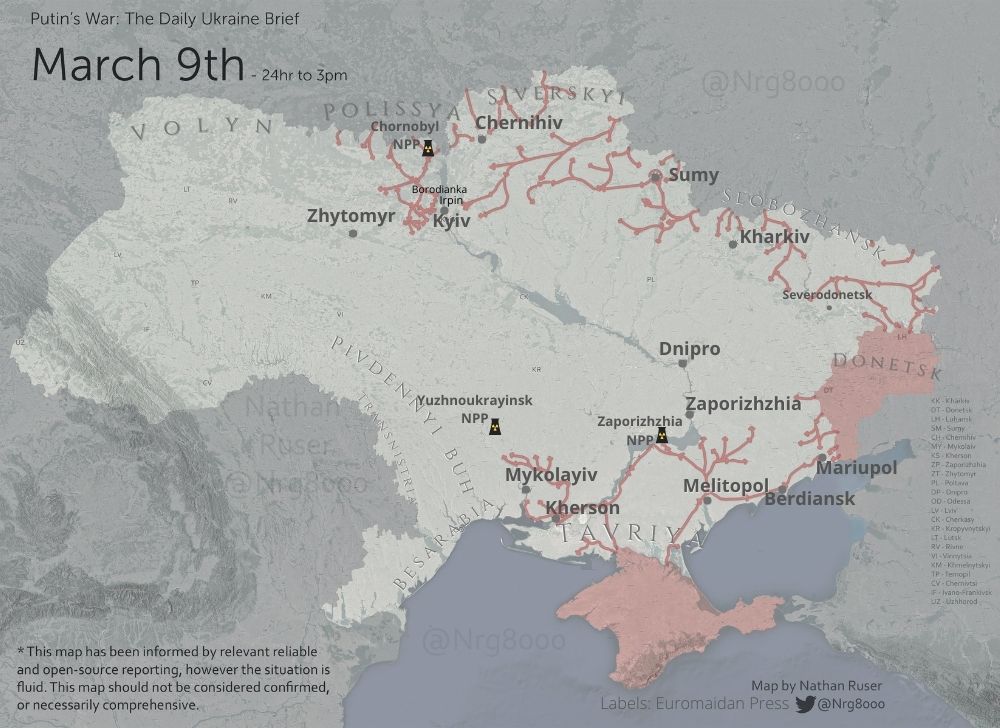This text was initially published in Ukrainian by Texty; it is based on an audio interview of Bielieskov, the text version was prepared by Valeriy Pavlenko
For decades, the West has feared Russian military power and has gone to great lengths to placate and “understand” the Kremlin. Russia’s invasion of Ukraine has changed the international community and the world as we know it.
What is the situation on Ukraine’s front lines? Why were western experts wrong and why they should be held accountable? How is Russia’s invasion of Ukraine reminiscent of the Soviet-Finnish War?
The goal of the Ukrainian Armed Forces is to exhaust or minimize the enemy’s offensive potential and stabilize certain territories. At the moment, the Ukrainian army and other security and defensive formations, as well as the civilian population, are coping with this difficult task.
But, this did not happen.
Yes, the enemy is advancing, but they have not achieved the goals set by the Kremlin. Commander-in-Chief of the Armed Forces Valeriy Zaluzhny and his team are coordinating and successfully implementing their strategic defensive operation.
Kyiv front line
From the moral and psychological point of view, Kyiv’s front line is of utmost importance as Ukraine’s military/political leadership and major infrastructure are located in the capital. Kyiv has been attacked from three directions: from the north-west, from Chernihiv and from Sumy Oblast.
Russia has not broken through major Ukrainian defensive positions, nor has it carried out far-reaching strikes or completely encircled major Ukrainian positions.
It should be understood that the Ukrainian army continues to shell all the areas currently occupied by the enemy. The Russians are under a constant barrage of fire; Ukrainian reconnaissance units patrol these areas and any major formations of enemy forces, equipment, or combat structures will be immediately destroyed.
30+ year-old Ukrainian aircraft and anti-missile systems have destroyed modern Russian fighter jets, such as SU-30SM and SU-35S. Ukraine’s MANPADS have downed Russia’s modern K-52 attack helicopters. To sum up, the north-western direction has been stabilized, and all possible areas where the enemy might advance are under Ukrainian control.
Sumy and Chernihiv front lines
In general, the Russian advance has been halted in and around the cities of Chernihiv and Sumy.
The enemy has not entered Sumy or Chernihiv but is trying to isolate them.
The Russian army will pay a high price for this, as they will need more men and equipment to enforce this decision. Furthermore, we all see that civilians organize resistance everywhere, destroying equipment and taunting the enemy.
The enemy has also isolated Okhtyrka and Lebedyn, but once again locals are not allowing enemy forces to push forward. The Ukrainian army fully controls the southern part of Sumy Oblast and the northern part of Poltava Oblast – the major channels leading from Kyiv to Kharkiv and for supplying humanitarian aid, reserves, and weapon systems.
Kharkiv front line
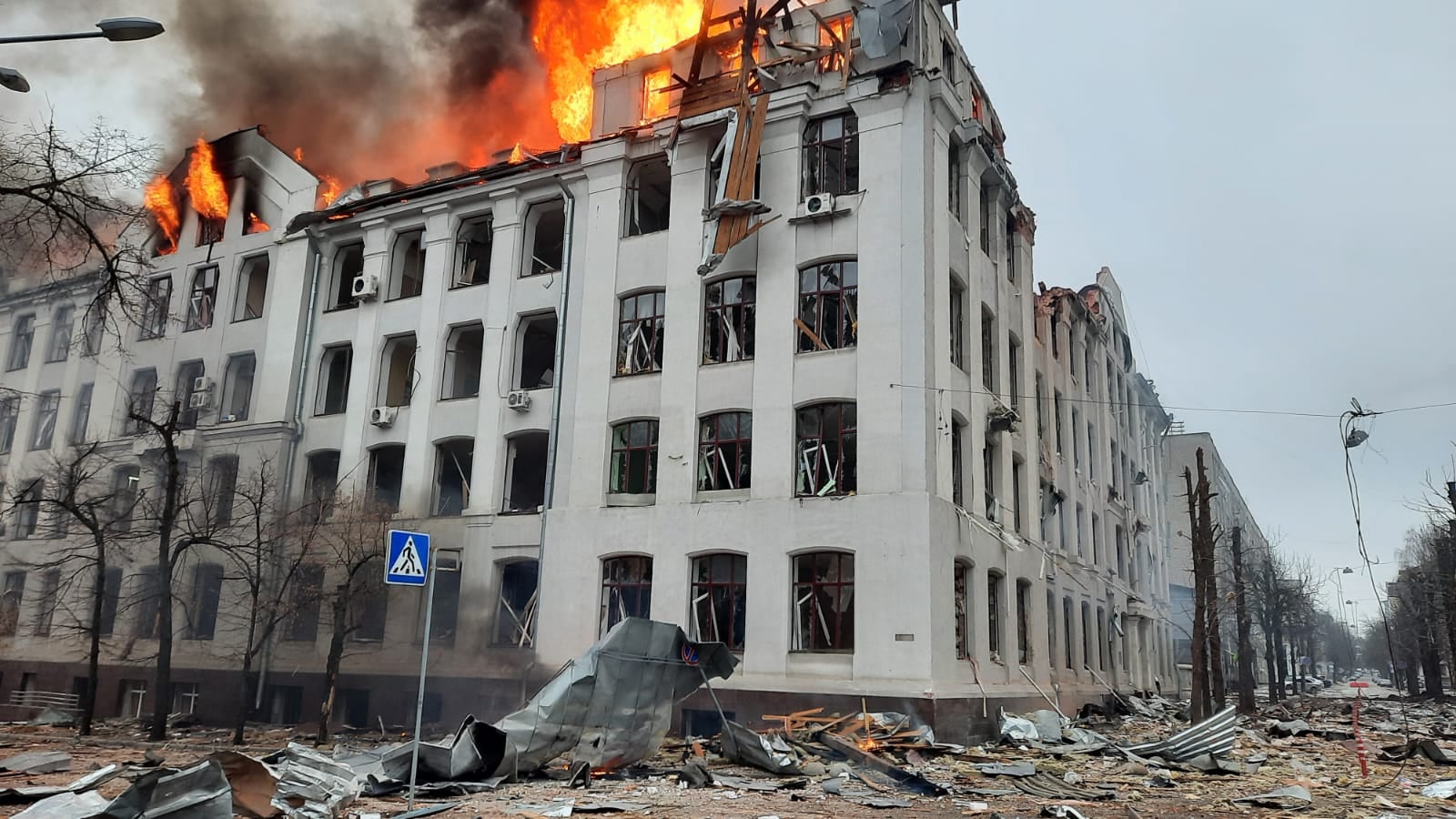
Despite systematic missile attacks, Kharkiv stands strong. Russia’s attempts to isolate this major Ukrainian city have failed.
Russian special forces tried to enter the city in Tigr mobility vehicles, but Ukrainian soldiers succeeded in burning all of them to the ground. With increasing cynicism, the Russians fired Russian-made 9M55K Smerch cluster munitions into residential areas, the SBU building, the National Guard office, and the city administration.
Donbas front line
As many Ukrainian brigades have been deployed to Luhansk and Donetsk Oblasts since 2014, the enemy has not made any significant advances. Russian forces have penetrated the area near Lysychansk, Sievierodonetsk, and Stanytsia Luhanska in Luhansk Oblast and Volnovakha in Donetsk Oblast, but do not advance further into the country.
Southern front line
The most difficult situation is in southern Ukraine. The Ukrainian Armed Forces did not have enough manpower to cover the long border and create a solid front line. Another choice was made - to defend Kyiv, Kharkiv, and the eastern flank.
As a result, the enemy managed to penetrate into Zaporizhzhia Oblast, and attempted to advance into Mykolayiv Oblast. Once again, the civilian population is demonstrating passive and active resistance.
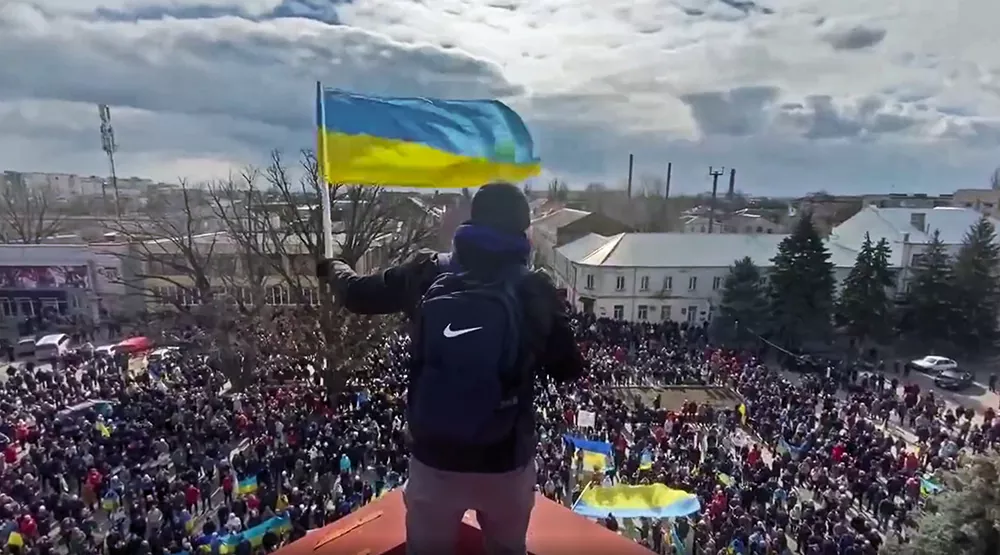
- Related: Ukrainians of occupied towns protest against Russian invaders, undermining “liberator” narrative
Tactics of exhaustion
The Ukrainian army has exhausted the enemy’s offensive potential in almost all directions. Compared to the first few days, combat intensity has decreased.
However, Ukraine’s goal is not only to tire the enemy, but also to gain time - launch domestic mobilization, prepare the entire country for longer war, and call for stronger international reactions. To date, western governments have imposed harsh sanctions and will supply Ukraine with more lethal defensive weapons.
This means that in the near future the situation should be stabilized and a strong defense should be built along all the front lines and especially on the southern flank.
Therefore, the strategic defensive operation implemented by the General Staff is yielding results. Ukraine has exhausted Russia’s offensive potential in several directions.
The enemy will pay a very high price, if they try to advance, as is evidenced by the number of Russians KIA, as well as by destroyed and burnt-out equipment, including the latest models of military hardware.
At this stage, the military/political leadership in Kyiv is performing its tasks effectively.
Ukraine needs modern military aircraft!
On February 7, the Biden administration stated that NATO allies could dispatch Soviet-era fighter jets to Ukraine.
[embedyt] https://www.youtube.com/watch?v=6ap3qWOfbcE[/embedyt]
NATO countries are equipped with modern fighter jets, equipment, and destruction warfare. So, Poland, Slovakia, and Bulgaria need not fear for their security if and when they finally decide to hand over their MiG-29s to Ukraine. These aircraft would significantly strengthen its air defense system.
The US has even supplied JASSM-ER cruise missiles to Eastern European countries; they can be fired from B-52s in the Baltic States and hit Moscow, relatively speaking.
Air defense systems are operational and enemy planes are regularly destroyed. Russia uses A-50U long-range radar reconnaissance aircraft over Belarus to coordinate its fighter jets. The A-50U radar is capable of detecting fundamentally new types of aircraft, and can simultaneously track a high number of targets and guided fighters. It is similar to AWACS, but not quite as effective, given poor Russian technology.
Ukrainian Intelligence regularly intercepts enemy planning of Russian A-50 aircraft working in cooperation with SU-35C. Ukraine’s partners and radar stations constantly monitor the air space and destroy enemy aircraft over the cities and towns. Before the invasion, over 100 stations in Ukraine were either repaired or replaced with new ones.
Ukraine must receive military aircraft, as Ukrainian pilots have already demonstrated what they can do with their old MiG-29s.
Why so many western experts were wrong
Many western and Ukrainian military experts, myself included, were wrong when we overestimated the Russian armed forces.
Why did this happen?
For the past 12 years, western military analysts have been fed stories about how effectively Russia has modernized its armed forces. Consequently, they wrote analyses and narratives that drove fear into the hearts of their governments, society, and the general public. The Center for Strategic and International Studies was more restrained in assessing Russia’s chances of achieving its goals so quickly and believed that Ukraine had a chance to fight and survive.
These western analysts are also to blame for this war. They are accomplices for western governments refusing to provide Ukraine with weapons, fearing that the country would fall in a few days.
Other experts write that it was necessary to take Russia’s interests into account. Such narratives amounted to nothing more than a policy of appeasement and enabled conditions for Russian aggression. The West had the opportunity to re-evaluate its policy in 2014, but thanks to those “experts,” Russia continued to receive resources and accumulate weapons systems, resulting in the invasion of Ukraine on February 24, 2022.
Looking at parallels in world history – the Soviet-Finnish War
What we have seen in these past few days is reminiscent of the Winter War of 1939-1940, when the Soviet Union led its troops against Finland. Implemented in 1928 until 1932, Stalin’s Five-Year Plan enabled the USSR to manufacture tons of heavy military equipment, thousands of tanks, artillery systems, and aircraft. Furthermore, the Soviet Union had a modern military doctrine both at the tactical and operational levels.
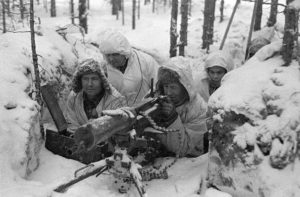
On the other side, Finland had a motivated infantry armed with machine guns, Molotov cocktails, and some pieces of artillery.
The first attempts in December 1939 to break through the Finnish defense on the Karelian Isthmus failed due to a complete lack of coordination between the different divisions. That is, the infantry advanced, but was not supported by the artillery, or the infantry advanced, but without tanks, etc.
Then, the Soviet Union stopped and regrouped, which took a month and a half. In mid-February, the Finnish command deployed a defense in depth (50-60km) in the area in front of the Mannerheim Line to delay the Red Army before it reached the line. The Soviet offensive operation lasted a month and a half.
Russia uses a lot of modern weapons: tanks, armored vehicles, armored combat vehicles, aircraft, and missiles. But, the Ukrainian infantry, together with tanks, artillery, manned and unmanned aerial vehicles, have managed to somewhat contain the advance of the Russian army.
But, there is one difference. Finland is a small country with limited manpower, and the Finnish forces were simply overwhelmed by the number of Soviet troops and weapons.
In fact, the Russians may begin to repeat the strategy they employed on the Mannerheim Line.
That is, a slow, but continuous advance supported by massive air and artillery strikes. However, it took the Soviet Union a month and a half to prepare, and another month to advance further, that is, two and a half months.
Currently, the Russian high command has changed its tactics in Ukraine and has launched a "scorched earth policy." To date, Russian aircraft and artillery engage in terrorist attacks and war crimes. They have turned their extensive military might against the Ukrainian people and civilian infrastructure.
The Ukrainian army on the ground and in the air
When all is said and done, it will be impossible for the enemy to eliminate 100% of Ukraine’s defense lines, aircraft, and artillery. Ukrainian soldiers use the terrain to reduce the effectiveness of Russian attacks, systematically destroying tanks and armored vehicles.
Fortunately, western partners have provided Ukraine with many different types of anti-tank weapons.
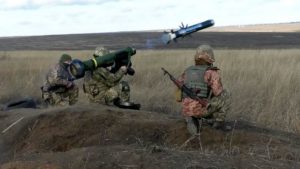
Russian aircraft are forced to fly low, not at medium altitudes, where they are shot down by air defense systems. And if they fly at low altitudes, the MANPADS become fully operational.
But, unlike more powerful weapons, MANPADS are effective only over ranges less than about seven kilometers and are used against aircraft that are within view of the operator.
As for Russian aviation, it is outdated and pilots are forced to fly at a low altitude in order to work more efficiently. So, these aircraft are either shot down by MANPADS, or they fly higher and have lower damage efficiency.
True, MANPADS will not destroy everything or everyone, but according to professional lingo, they will reduce the effectiveness of different airstrike systems. This is what Ukraine needs.
Therefore, Ukrainian ground forces will continue destroying and burning armored vehicles, even if the Russians change tactics. Even though Ukraine has not yet received the promised fighter jets, American Stingers and British NLAW systems are here and should be used with maximum efficiency.
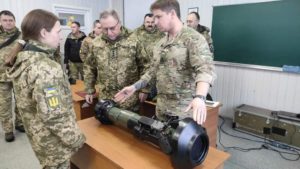
Today, Ukraine must demand that the countries of Central and Eastern Europe supply munitions, which are stored in the Czech Republic and Bulgaria and fully protected by the NATO umbrella. Besides MiG-29 aircraft, Ukraine needs more ammunition for Grad rocket launchers, 152 mm, 122mm artillery, and for D-30 and 2-C1 Gvozdika howitzers.
The war has not gone Russia’s way
The Ukrainian army and its security and defense forces have shattered the myth of a powerful Russian army. This is the same army that attacked Finland in 1939 and Chechnya in 1994-96 and in 1999.
Predictions about how quickly Kyiv will be encircled or fall have not come true; predictions about complete air supremacy, predictions about complete Internet shutdown, and incessant cyberattacks have fallen flat.
Not only have the Armed Forces of Ukraine shown that the Russian army can be halted and destroyed, but also that American expertise and Western intelligence assessments were basically wrong. They predicted an apocalypse in Ukraine and that Ukrainians would soon be forced to launch guerrilla resistance throughout the country.
To date, there is no guerrilla war. There is, of course, civil resistance in the regions where the enemy has advanced, and it complements the systematic resistance by Ukrainian regular forces.
Ukrainians will continue to resist. The Russians do not control anything except the roads along which they travel.
Even the cities currently occupied by Russian troops - Sumy, Okhtyrka, Lebedyn, Konotop, Melitopol, Berdiansk, Kherson - show defiant resistance. It is either passive resistance (showing the middle finger, singing the anthem, raising the flag or blocking tank columns) or active resistance (transmitting coordinates to Ukrainian drones, destroying support columns and pieces of equipment).
Once again, Russia does not control any Ukrainian territories, except for the temporarily occupied territories of Crimea and parts Donetsk and Luhansk Oblasts in the Donbas.
This is a very important point. Don’t trust all those maps where "new territories" are marked in red, territories that are allegedly controlled and occupied by Russia. Even in the regions where people voted for the pro-Russian Opposition Platform For Life party, no one rushes out to meet the enemy.
In the end, this is truly a people’s war, a sacred war for the survival of Ukraine.

Mykola Bielieskov is a Research Fellow at the National Institute for Strategic Studies under the President of Ukraine. The expressed views are that of the author only and don't represent the official position of National Institute for Strategic Studies
Related:
- Ukrainians of occupied towns protest against Russian invaders, undermining “liberator” narrative
- International sanctions slam Russia’s finance, economy, culture, sports: a list
- How weapons from allies would help Ukraine fend off Russia’s invasion


